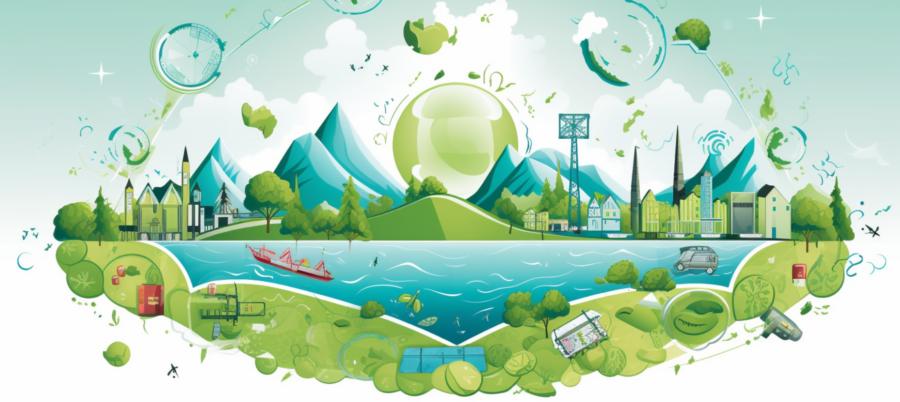Circular Economy: Business Models for Sustainability

Defying the Linear Logic of it All
Picture this: you’re a bottle of water. A proud, 500 milliliters of quenching goodness. One day, you’re on the top shelf in a supermarket, basking under fluorescent lights, and the next, you’re empty, discarded, and well, you’re just trash now. Congratulations, you’ve just gone full circle in the linear economy. It’s like an elongated version of musical chairs, where once the music stops, you’ve lost your one and only purpose.But what if you could keep playing? What if you could be reborn as a water bottle, or perhaps even something more ambitious like a park bench or a pair of sunglasses? That’s the idea behind the circular economy - a business model that focuses on reusing, recycling, and regenerating resources to ensure long-term sustainability. It’s an effort to break free from the shackles of the linear economy, where "take, make, and dispose" has been the prevailing motto.
Lessons from Nature: Mother Knows Best
Before you start thinking that the circular economy is a conspiracy by eco-hippies, consider this: nature has been pulling off this sustainability trick for eons. Trees die, decompose, and become nutrients for new trees to grow. The water you just drank (or contained, if you’re still the bottle) was once dinosaur sweat.That’s right - nature is the original eco-warrior, and it’s about time we all learn a thing or two from our biological mum. The circular economy aims to mimic natural processes and eliminate that pesky concept of “waste.” Because, in nature, there is no such thing as waste - everything is a resource waiting to be utilized.
Turning Trash into Treasure: The Business of Sustainability
When you look at the world through circular economy goggles, opportunities for innovation and profit abound. Far from being a hindrance to the capitalist spirit, the circular economy can boost economic growth and create jobs while reducing environmental impacts. How’s that for a win-win-win?Here are a few examples of business models that are embracing the circular economy:
- Product as a Service: Instead of selling products, companies provide access to products as a service. Take car-sharing services like Zipcar, for example. Or Mud Jeans, a Dutch company that leases jeans to customers who then return them to be recycled into new jeans. It’s like borrowing your sibling's clothes, only without the inevitable fight.
- Remanufacturing: Companies take back old products, disassemble them, and use the parts to produce new products. This is a common practice in the automotive and aerospace industries. Caterpillar, for example, is known for its remanufacturing program that has saved billions of dollars and reduced millions of tons of waste. They’ve also probably saved a few caterpillars along the way.
- Upcycling: Instead of recycling materials down to lower value applications, upcycling adds value by turning waste into new, higher quality products. Terracycle is an upcycling champion, turning non-recyclable waste like chip bags and toothbrushes into new products like tote bags, pencil cases, and park benches. They’re like the fairy godmother of trash.
Joining the (Re)cycle: How to Embrace the Circular Economy
Whether you’re an entrepreneur, a corporate giant, or just a regular bloke who likes to use a reusable shopping bag, there are ways for everyone to get in on the circular economy action:- Collaborate: Work together with suppliers, customers, and even competitors to share resources, knowledge, and ideas. Because, as the saying goes, “Teamwork makes the green work.” (Okay, I made that up, but it should be a saying.)
- Design for Disassembly: Create products that can be easily taken apart and reused or recycled. Think modular phone components or furniture that can be disassembled and reassembled like a never-ending game of Tetris.
- Shift from Ownership to Access: Embrace the sharing economy and provide products as a service. It’s like the old saying goes, “If you love something, set it free - and charge a subscription fee.”
Article kindly provided by b2bwize.com
Latest Articles
- How to Choose Eco-Friendly Transportation Without Sacrificing Comfort
- Spotting Underserved B2B Niches by Analyzing Local Service Ecosystems
- Why Businesses Chronically Underestimate Waste Volume and How to Fix It
- Why Moisture Risk Assessments Should Happen Before Design Sign-Off
- The Hidden Cost of Deferred Drainage Maintenance in Commercial Buildings
- Finding Efficient Balance Between Shared and Private Group Transport
- Mountain Miles and Corporate Smiles
- Uniforms Matter More Than You Think
- Dental Workflow Mistakes Small Practices Don't Realize They're Making
- Blending Present-Day Hospitality With the Charm of Heritage Architecture
- Local Directories Reduce Decision Fatigue in a Crowded Online World
- Everyday Moments That Spark Social Media Magic for Vet Teams
- From Delivery Vans to VIP Access: Smart Gate Controls for Busy Commercial Entrances
- Kitchen Renovation for Quiet Collaboration: How Thoughtful Design Encourages Cross-Team Connection
- Why Certain Swiss Timepieces Gain Value After Their First Owner
- Modern UK Office Kitchen Layouts for Hybrid and Tech-Driven Teams
- Why B2B Companies Need Specialized SEO Services to Drive Qualified Leads
- Anti-Fatigue Floor Solutions for Home Offices, Retail and Studios
- When Flow Reverses and Everything You Thought Was One-Way Isn't
- When Your Office's Nervous System Fails and How to Sense Electrical Faults Before They Burn Out
- Sales and Marketing
- Human Resources
- Finance and Accounting
- Business Consulting
- Information Technology
- Supply Chain Management
- Manufacturing and Production
- Logistics and Transportation
- Risk Management
- Project Management
- Market Research
- Business Intelligence
- Customer Relationship Management
- Product Development
- Quality Assurance
- Outsourcing Services
- Procurement and Vendor Management
- Legal and Compliance
- Business Strategy
- Operations Management
- Leadership and Management
- Data Analytics
- Innovation and R&D
- Training and Development
- Ecommerce Solutions
- Public Relations
- Advertising and Promotion
- Branding and Identity
- Business Networking
- Event Management
- Office Environment

